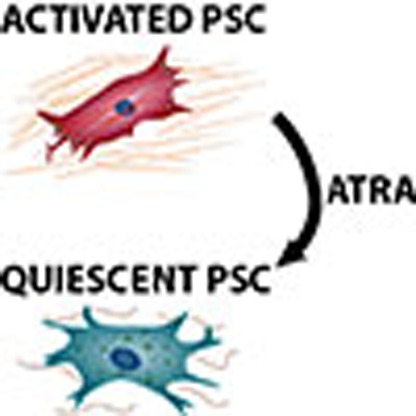- Record: found
- Abstract: found
- Article: found
ATRA mechanically reprograms pancreatic stellate cells to suppress matrix remodelling and inhibit cancer cell invasion

Read this article at
Abstract
Pancreatic ductal adenocarcinoma (PDAC) is a highly aggressive malignancy with a dismal survival rate. Persistent activation of pancreatic stellate cells (PSCs) can perturb the biomechanical homoeostasis of the tumour microenvironment to favour cancer cell invasion. Here we report that ATRA, an active metabolite of vitamin A, restores mechanical quiescence in PSCs via a mechanism involving a retinoic acid receptor beta (RAR-β)-dependent downregulation of actomyosin (MLC-2) contractility. We show that ATRA reduces the ability of PSCs to generate high traction forces and adapt to extracellular mechanical cues (mechanosensing), as well as suppresses force-mediated extracellular matrix remodelling to inhibit local cancer cell invasion in 3D organotypic models. Our findings implicate a RAR-β/MLC-2 pathway in peritumoural stromal remodelling and mechanosensory-driven activation of PSCs, and further suggest that mechanical reprogramming of PSCs with retinoic acid derivatives might be a viable alternative to stromal ablation strategies for the treatment of PDAC.
Abstract
 Persistent activation of pancreatic stellate cells (PSCs) can perturb the biomechanical
homeostasis of the tumour microenvironment. Here the authors show that all-trans retinoic
acid reduces retinoic acid receptor beta dependent-actomyosin contractility and restores
mechanical quiescence in PSCs.
Persistent activation of pancreatic stellate cells (PSCs) can perturb the biomechanical
homeostasis of the tumour microenvironment. Here the authors show that all-trans retinoic
acid reduces retinoic acid receptor beta dependent-actomyosin contractility and restores
mechanical quiescence in PSCs.
Related collections
Most cited references51
- Record: found
- Abstract: found
- Article: not found
Vitamin D receptor-mediated stromal reprogramming suppresses pancreatitis and enhances pancreatic cancer therapy.
- Record: found
- Abstract: found
- Article: not found